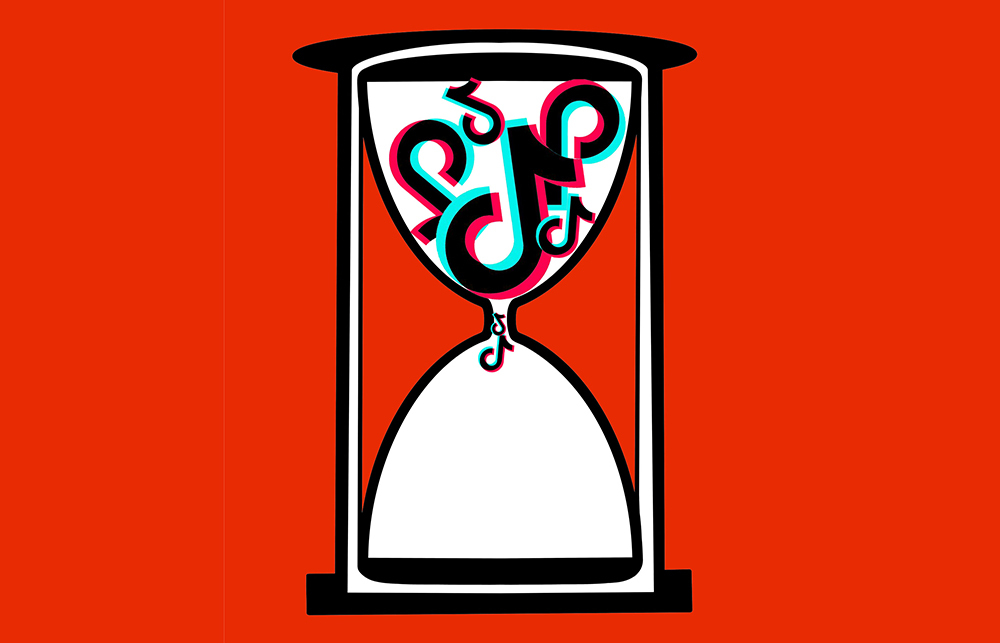有傳聞稱,,TikTok會成為中美關(guān)系日益緊張的下一個犧牲品,。據(jù)媒體報道,,出于“網(wǎng)絡(luò)安全”擔(dān)憂,特朗普政府計劃禁用這款中國應(yīng)用程序,,并且大公司和政府機(jī)構(gòu)已經(jīng)警告員工不要在辦公設(shè)備上使用這款應(yīng)用程序,。但與此同時,各大品牌商卻投入大量資金在TikTok上打廣告,。
即使TikTok可能被禁用也沒有打消品牌商的熱情,,他們甚至?xí)嬖V你,在TikTok上打廣告回報高,,值得冒險,。對于仍然在觀望的品牌商而言,在TikTok上大力投放贊助廣告,將提高銷量和品牌知名度,,無論這款應(yīng)用程序的最終命運(yùn)會如何,。最糟糕的情況是TikTok被禁用,但品牌商依舊有機(jī)會在TikTok的用戶中提高品牌知名度,;最好的結(jié)果是TikTok幸免于難,,品牌商可以在該平臺上站穩(wěn)腳跟,,迎來繁榮增長,。

TikTok的設(shè)計以用戶參與為核心,這是其他視頻分享應(yīng)用程序所不具備的(比如Vine),。所以,,品牌商和內(nèi)容創(chuàng)作者只要很短時間就能在該平臺上獲利。即使在TikTok前途未卜的情況下,,聰明的品牌商也不會放棄這款廣告工具,。65.3%的TikTok用戶不超過29歲,所以在該平臺上投放廣告,,就是在投資這批受眾的購買力,。隨著用戶年齡的增長,他們的購買力只會增強(qiáng)并且日益成熟,。只要他們最喜歡的應(yīng)用程序依舊存在,,品牌商就應(yīng)該面向他們投放廣告,這是顯而易見的,。
TikTok上的內(nèi)容會在短期內(nèi)被看到并促使用戶采取行動,。這款應(yīng)用程序上的一個熱門話題或挑戰(zhàn)的平均壽命只有一周左右。不過TikTok視頻并不像YouTube和Instagram等平臺上的視頻一樣,,具有經(jīng)久不衰的價值,,但它們根本不需要這樣的價值!一條視頻走紅不需要太長時間:去年夏天,,Chipotle的#GuacDance挑戰(zhàn)只持續(xù)了六天,,用戶提交了25萬條TikTok視頻,播放次數(shù)達(dá)到4.3億次,,鱷梨醬的使用量增加了68%,。迅速在TikTok上投放廣告的品牌商,也將很快受益,。一條熱門廣告能夠提高長期品牌認(rèn)知度,,這種效應(yīng)不會隨著這款應(yīng)用程序被禁用而消失。
前不久,,許多品牌商抵制Facebook廣告,,因此他們更有理由將TikTok作為一個既有成本效益又有影響力的渠道去接觸年輕受眾。前文所述的29歲以下的用戶也是Instagram的主力用戶群體,但他們不再像以前一樣使用Facebook,。要想讓這個群體重新了解一個品牌,,品牌商只需要花很少的錢聘請小網(wǎng)紅在TikTok上發(fā)起一項活動。
但如果美國政府確實祭出禁令呢,?當(dāng)TikTok謝幕,,而各大品牌仍在加大宣傳支出的時候,品牌商為這個平臺制定的預(yù)算將流向何方,?在TikTok上成名(并賺的盆滿缽滿)的網(wǎng)紅們怎么辦,?
TikTok有出色的編輯能力和視覺特效,但它的模式并非專利,,F(xiàn)acebook,、Snapchat和Instagram等大平臺都有資源嘗試復(fù)制這種模式,而且許多平臺會抓住機(jī)會,。大部分TikTok用戶可能已經(jīng)在使用這些平臺,,他們或許會成為被動的廣告受眾。
網(wǎng)紅們要想維持與美國粉絲和品牌商的聯(lián)系,,他們別無選擇,,只能轉(zhuǎn)戰(zhàn)其他平臺。Snapchat和YouTube等擁有強(qiáng)大視頻功能的應(yīng)用程序會涌入大批新網(wǎng)紅,,希望把他們在TikTok上的成功延續(xù)到新的平臺,。
品牌商應(yīng)該關(guān)注用戶和網(wǎng)紅們的習(xí)慣,但他們也不應(yīng)該低估市場活動的影響,。美國政府正在考慮禁用TikTok的消息曝光之后,,Snap的股價大漲6.5%,這表明華爾街認(rèn)為Snap可能會接收TikTok的用戶和廣告商,。隨著各大品牌商繼續(xù)抵制Facebook(包括Instagram),,Snapchat可能會成為市場爭奪者之一。
當(dāng)然,,在疫情期間捂緊錢袋的品牌商可以選擇徹底砍掉在TikTok上的支出,,付出的代價就是發(fā)展勢頭受阻。萬一政府發(fā)布禁令然后撤銷禁令,,那些在禁令之前押注TikTok的品牌商,,將比小心翼翼的品牌商們獲得更多優(yōu)勢。
TikTok主要面向“95后”,,是增長最快的社交媒體平臺,。對于這樣一個平臺,品牌商值得冒險加以利用,。如果TikTok被禁用,,這些勇于冒險的品牌商也會馬上追隨客戶(和他們的錢包)轉(zhuǎn)到其他平臺,。對此,我的建議是品牌商要敢于冒險,。(財富中文網(wǎng))
本文作者賈斯汀?克蘭是網(wǎng)紅營銷技術(shù)合作伙伴與平臺Markerly的聯(lián)合創(chuàng)始人,。該平臺的合作伙伴包括許多全球最大的消費(fèi)品牌。
譯者:Biz
有傳聞稱,,TikTok會成為中美關(guān)系日益緊張的下一個犧牲品,。據(jù)媒體報道,出于“網(wǎng)絡(luò)安全”擔(dān)憂,,特朗普政府計劃禁用這款中國應(yīng)用程序,,并且大公司和政府機(jī)構(gòu)已經(jīng)警告員工不要在辦公設(shè)備上使用這款應(yīng)用程序。但與此同時,,各大品牌商卻投入大量資金在TikTok上打廣告,。
即使TikTok可能被禁用也沒有打消品牌商的熱情,他們甚至?xí)嬖V你,,在TikTok上打廣告回報高,值得冒險,。對于仍然在觀望的品牌商而言,,在TikTok上大力投放贊助廣告,將提高銷量和品牌知名度,,無論這款應(yīng)用程序的最終命運(yùn)會如何,。最糟糕的情況是TikTok被禁用,但品牌商依舊有機(jī)會在TikTok的用戶中提高品牌知名度,;最好的結(jié)果是TikTok幸免于難,,品牌商可以在該平臺上站穩(wěn)腳跟,迎來繁榮增長,。
TikTok的設(shè)計以用戶參與為核心,,這是其他視頻分享應(yīng)用程序所不具備的(比如Vine)。所以,,品牌商和內(nèi)容創(chuàng)作者只要很短時間就能在該平臺上獲利,。即使在TikTok前途未卜的情況下,聰明的品牌商也不會放棄這款廣告工具,。65.3%的TikTok用戶不超過29歲,,所以在該平臺上投放廣告,就是在投資這批受眾的購買力,。隨著用戶年齡的增長,,他們的購買力只會增強(qiáng)并且日益成熟。只要他們最喜歡的應(yīng)用程序依舊存在,,品牌商就應(yīng)該面向他們投放廣告,,這是顯而易見的,。
TikTok上的內(nèi)容會在短期內(nèi)被看到并促使用戶采取行動。這款應(yīng)用程序上的一個熱門話題或挑戰(zhàn)的平均壽命只有一周左右,。不過TikTok視頻并不像YouTube和Instagram等平臺上的視頻一樣,,具有經(jīng)久不衰的價值,但它們根本不需要這樣的價值,!一條視頻走紅不需要太長時間:去年夏天,,Chipotle的#GuacDance挑戰(zhàn)只持續(xù)了六天,用戶提交了25萬條TikTok視頻,,播放次數(shù)達(dá)到4.3億次,,鱷梨醬的使用量增加了68%。迅速在TikTok上投放廣告的品牌商,,也將很快受益,。一條熱門廣告能夠提高長期品牌認(rèn)知度,這種效應(yīng)不會隨著這款應(yīng)用程序被禁用而消失,。
前不久,,許多品牌商抵制Facebook廣告,因此他們更有理由將TikTok作為一個既有成本效益又有影響力的渠道去接觸年輕受眾,。前文所述的29歲以下的用戶也是Instagram的主力用戶群體,,但他們不再像以前一樣使用Facebook。要想讓這個群體重新了解一個品牌,,品牌商只需要花很少的錢聘請小網(wǎng)紅在TikTok上發(fā)起一項活動,。
但如果美國政府確實祭出禁令呢?當(dāng)TikTok謝幕,,而各大品牌仍在加大宣傳支出的時候,,品牌商為這個平臺制定的預(yù)算將流向何方?在TikTok上成名(并賺的盆滿缽滿)的網(wǎng)紅們怎么辦,?
TikTok有出色的編輯能力和視覺特效,,但它的模式并非專利,F(xiàn)acebook,、Snapchat和Instagram等大平臺都有資源嘗試復(fù)制這種模式,,而且許多平臺會抓住機(jī)會。大部分TikTok用戶可能已經(jīng)在使用這些平臺,,他們或許會成為被動的廣告受眾,。
網(wǎng)紅們要想維持與美國粉絲和品牌商的聯(lián)系,他們別無選擇,,只能轉(zhuǎn)戰(zhàn)其他平臺,。Snapchat和YouTube等擁有強(qiáng)大視頻功能的應(yīng)用程序會涌入大批新網(wǎng)紅,希望把他們在TikTok上的成功延續(xù)到新的平臺,。
品牌商應(yīng)該關(guān)注用戶和網(wǎng)紅們的習(xí)慣,,但他們也不應(yīng)該低估市場活動的影響,。美國政府正在考慮禁用TikTok的消息曝光之后,Snap的股價大漲6.5%,,這表明華爾街認(rèn)為Snap可能會接收TikTok的用戶和廣告商,。隨著各大品牌商繼續(xù)抵制Facebook(包括Instagram),Snapchat可能會成為市場爭奪者之一,。
當(dāng)然,,在疫情期間捂緊錢袋的品牌商可以選擇徹底砍掉在TikTok上的支出,付出的代價就是發(fā)展勢頭受阻,。萬一政府發(fā)布禁令然后撤銷禁令,,那些在禁令之前押注TikTok的品牌商,將比小心翼翼的品牌商們獲得更多優(yōu)勢,。
TikTok主要面向“95后”,,是增長最快的社交媒體平臺。對于這樣一個平臺,,品牌商值得冒險加以利用,。如果TikTok被禁用,這些勇于冒險的品牌商也會馬上追隨客戶(和他們的錢包)轉(zhuǎn)到其他平臺,。對此,,我的建議是品牌商要敢于冒險。(財富中文網(wǎng))
本文作者賈斯汀?克蘭是網(wǎng)紅營銷技術(shù)合作伙伴與平臺Markerly的聯(lián)合創(chuàng)始人,。該平臺的合作伙伴包括許多全球最大的消費(fèi)品牌。
譯者:Biz
TikTok is rumored to be the next casualty of growing tensions between the U.S. and China. The Trump administration is reportedly looking at banning the Chinese app over cybersecurity concerns, and major companies and government entities have warned employees against using the app on corporate-owned devices. This news comes at a time when brands are shelling out major cash to advertise on TikTok.
Even in the face of a potential ban, brands won’t be deterred and might even tell you that the rewards of TikTok make it worth the risk. For those on the fence, going all-in on sponsored campaigns now will drive sales and awareness—regardless of the fate of the app. In the worst-case scenario, TikTok is banned, but you had one last chance to make a name for your brand among users; in the best-case scenario, TikTok survives, and you’ve established a foothold there that will grow and thrive with the app.
TikTok is built for participation and engagement in a way that no other video sharing app is or was (sorry, Vine). So naturally, it didn’t take long for brands and creators to monetize the platform. Even with an uncertain fate, smart brands won’t shy away from it as an advertising tool. Of TikTok users overall, 65.3% are under 29, so to invest in campaigns on the platform is to invest in this audience’s buying power, which will only grow and mature as they do. As long as their favorite app still exists, reaching them there with ads is a no-brainer.
TikTok’s content is meant to be consumed and acted on immediately. The shelf life of an average meme or challenge on the app is roughly a week. Videos on TikTok don’t have the same evergreen value as their cousins on YouTube and Instagram—but they don’t need it! It doesn’t take long to make an impact: Last summer, Chipotle’s #GuacDance challenge ran for just six days and garnered 250,000 TikTok submissions and 430 million video starts, all resulting in a 68% increase in avocado usage. Brands that act fast to launch TikTok advertising will reap the benefits just as quickly. One viral campaign can lead to long-term brand recognition that could outlast the app itself.
With many brands boycotting advertising on Facebook, TikTok is in an even stronger position as a cost-effective and impactful channel for reaching younger audiences. The aforementioned under-29 crew has a strong presence on Instagram but isn’t using Facebook like it used to. A single low-cost micro-influencer campaign on TikTok could be all it takes for a brand to reawaken awareness among this group.
Let’s get real for a second: It’s more likely that TikTok will leave China before the U.S. bans it. But what if a ban does occur? As TikTok sings its proverbial swan song and brands go all-in on spending, where will budgets earmarked for the platform go? And what about the influencers who have made names (and millions) for themselves?
TikTok has incredible editing capabilities and visual effects, but its model isn’t proprietary—major platforms like Facebook, Snapchat, and Instagram all have the resources to attempt to replicate it, and many will seize the opportunity. The majority of TikTok users likely already have a presence on these networks and may be a captive audience.
If influencers want to remain engaged with U.S. followers and brands, they will have no choice but to explore other platforms. Apps with robust video offerings such as Snapchat and YouTube could see an influx of new influencers looking to carry their TikTok success over to a new setting.
Brands should pay attention to user—and influencer—habits, but they also shouldn’t discount market activity. Snap’s stock jumped 6.5% following the announcement discussing the potential ban, indicating that Wall Street believes it may be well positioned to become the beneficiary of TikTok’s users and advertisers. With brands committing to a wholesale Facebook boycott (including Instagram), Snapchat could become that much more of a contender.
Of course, brands keeping their purse strings tight during the pandemic may elect to pause spending on TikTok entirely—and will end up paying for it in the form of stymied momentum. If a ban occurs, which is then reversed, the brands who gambled on TikTok pre-ban will have an edge over those who played it safe.
The ability to tap into the fastest-growing social platform geared specifically toward Generation Z makes TikTok a risk worth taking—despite the prospect of a national ban. And if TikTok is banned, those same risk-taking brands won’t waste time following their customers and their wallets to another platform. My advice is to take the risk.
Justin Kline is cofounder of Markerly, an influencer marketing technology partner and platform working with some of the largest consumer brands in the world.






